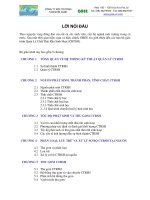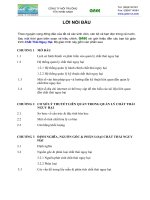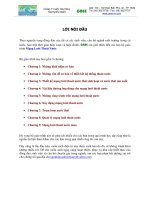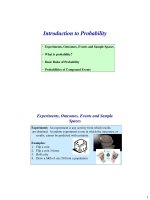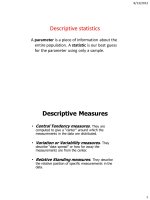Tài liệu tiếng anh - LAMNGHIEPVN.INFO (Hưng Bùi) REFERENCES
Bạn đang xem bản rút gọn của tài liệu. Xem và tải ngay bản đầy đủ của tài liệu tại đây (91.46 KB, 3 trang )
REFERENCES
[1] Allen, J.P.B. & Windowson, H.G. (1974), English in Focus: English in
Agriculture, OUP, Oxford.
[2] Bates, M. & Dudley-Evans, A. (1976), Nucleus: General Science, Longman.
[3] Barden, H. & Parrish (1987), Plant Science, McGraw-Hill.
[4] Buckett (1980), Introduction to Livestock Husbandry, Pergamon Press.
[5] Candlin, C.N. (1984), “Syllabus Design as a Critical Process” in Language
Learning and Education, C.J.Brumfit (ed.), 1984a.
[6] Carroll, B.J. (1980), Testing Communicative Performance, Pergamon.
[7] Chitravelu, N. (1980), “English for Special Purposes Project” in ELT
Documents 107, British Council.
[8] Close, R.A. (1965), The English We Use for Science, Longman.
[9] Coffey, B. (1980), “English for Academic Purposes”, Paper presented at the
Regional Language Centre (R.E.L.C), Singapore, Seminar, March 1980.
[10] Coffey, B. (1984), “ESP-English for Specific Purposes” in Language Teaching
Vol.17, No.I, January 1984, Cambridge University Press.
[11] Crymes, R.H. (1978), The Developing Art of TESOL: Theory and Practice in
C.H. Blatchford and J. Schachter, Washington D.C.
[12] Denny, S. ,Kerr, L., Phillips, M., Shettlesworth, C. (1985), Agriculture,
Nucleus, Longman.
[13] Ewer, J.R & Latorre, G. (1967), “Preparing an English Course for Students of
Science” in English Language Teaching Journal, Vol. 21, 3, 1967, pp.221 229.
[14] Ewer, J.R. & Latorre, G. (1969), A Course in Scientific English, Longman.
[15] Ewer, J.R. (1971), “Further Notes on Developing an English Programme for
Students of Science and Technology” in English Language Teaching, Vol. 15,
No. I, 1971, pp. 65 - 70.
[16] Ewer, J.R. & Hughes-Davies, E. (1972), “Further Notes on Preparing an
English Programme for Students of Science and Technology” in English
Teaching Journal, Vol. 26, 3, 1972, pp. 269 - 273.
[17] Halliday, M.A.K., McIntosh, A. & Strevens, P. (1964), The Linguistic Sciences
and language Teaching, London, Longman, pp. 190.
[18] Halliday, M.A.K. (1969), “Existing Research and Future Work” in Language
for Special Purposes, CILT Reports and Papers No. I, CILT, 1969.
[19] Herbert, A.J. (1965), The Structure of Technical English, Longman.
[20] Holliday, A. & Cooke, T. (1988), “An Ecological Approach to ESP”, ELT
Journal, Vol. 42/2, April 1988, Oxford University Press.
[21] Hutchinson, T. & Waters, A. (1989), English for Specific Purposes: A
Learning-Centred Approach, CUP, Cambridge.
[22] Huxley, P. & Van Housten, H. (1997), Glossary for Agroforestry, International
Centre for Research in Agroforestry, English Press, Nairobi, Kenya.
[23] James, C.V. (1972), “A Note On Language Skills”, in CILT Reports and
Papers No.8, September 1972.
[24] Jordan, R.R. (1977), Identification of Problems and Needs: a Student Profile,
in Cowie and Heaton, pp. 12 - 20.
[25] Joy & Wibberley (1979), A Tropical Agriculture Handbook, Cassel
[26] Lassoie, J.P., Buck, E. & Fernandes, E.C.M. (1999), Agroforestry in
Sustainable Agricultural System, CRC Press LLC, Lewis Publishers.
[27] Lockhart & Wiseman (1988), Introduction to Crop Husbandry, 6th ed.,
Pergamon Press.
[28] Mackay, R. & Mountford, A. (1978), English for Specific Purposes, Longman.
[29] Mackay, R. (1978), “Identifying the Nature of the Learner’s Needs” in
Mackay, R. and Mountford, A. (eds.) (q.v), pp.21 - 37.
[30] Mackay, R. & Palmer, J.D. (1981), Language for Specific Purposes: Program
Design and Evaluation, Newburry House.
[31] Mackay, R. (1983), “The Need for Close Integration of Components in ESP
Programs” in The ESP Journal, Vol.2, No.11983, pp. 58 - 59.
[32] Mc Donough, J. (1984), ESP in Perspectives - A Practical Guide, Collins ELT:
London and Glasgow.
[33] Morrow, K. (1977), “Authentic tests and ESP”, in Holden (ed.) (q.v. 1977), pp.
13 - 15.
[34] Munby, J.L. (1977), “Processing Profiles of Communicative Needs” in the
British Council, Bogota, pp. 15 - 22.
[35] Munby, J.L. (1978), Communicative Syllabus Design, Cambridge: Cambridge
University Press.
[36] Phillips, M., Shettesworth, C., Kerr, L., & Denny, S. (1974), “Some Linguistics
and Functional Aspects of an English Course for Students in Agriculture”,
Paper Delivered at the 4th Annual Seminar of Association of Professors of
English in Iran, 14th - 17th March 1974, British Council.
[37] Robinson, P. (1980), ESP: The Current Position, Pergamon Press.
[38] Robinson, W. (1981), “The Helpful EST Teacher” in ELT Documents 112,
British Council. pp. 28 - 32.
[39] Rudebject, P.G. & Del Castillo, R.A. (1998), How Agroforestry is Taught in
Southeast Asia,ICRA.
[40] Rudebject, P. (1999), Guiding Learning Agroforestry, ICRA.
[41] Smith, F. (1984), “The Promise and Perils of Computerized Instruction”, Paper
presented at Dartmouth House, June 1984, London.
[42] Van Ek, J. (1975), Threshold Level English, Oxford: Pergamon.
[43] Waters, A. (1982), Issues in ESP, Pergamon Press.
[44] Widdoson, H.G. (1976), “The Authenticity of Language Data”, in Fanselow,
J.F. and Grymes, R.H. (eds) on TESOL’ 76 TESOL, Washington D.C.
[45] Widdowson, H.G. (1981), “English for Specific Purposes: Criteria for Course
Design", in English for Academic and Technical Purposes: Studies in Honor of
Louis Trimble, Selinker, L. , Tarone, E. & Hanzel, V. (eds.), Newburry House.
[46] Yalden, J. (1984), Syllabus Design in General Education, in C.J.Brumfit,
1984a.
[47] Yalden, J. (1987), Principles of Course Design for Language Teaching,
Canbridge, UK: Cambridge University Press.
[48] Yates, C.St.J. (1987), Agricuture, Pergamon Press.
&
